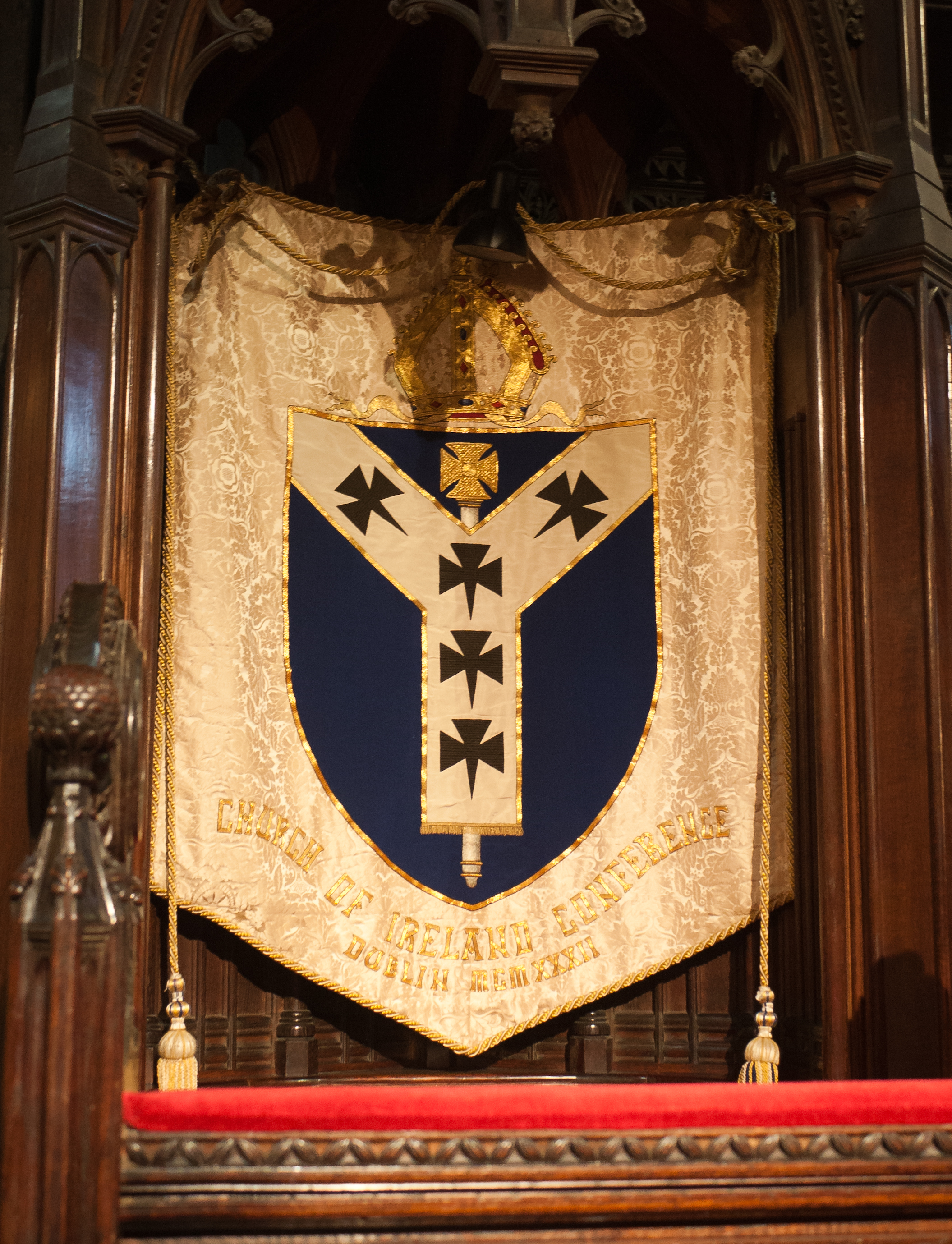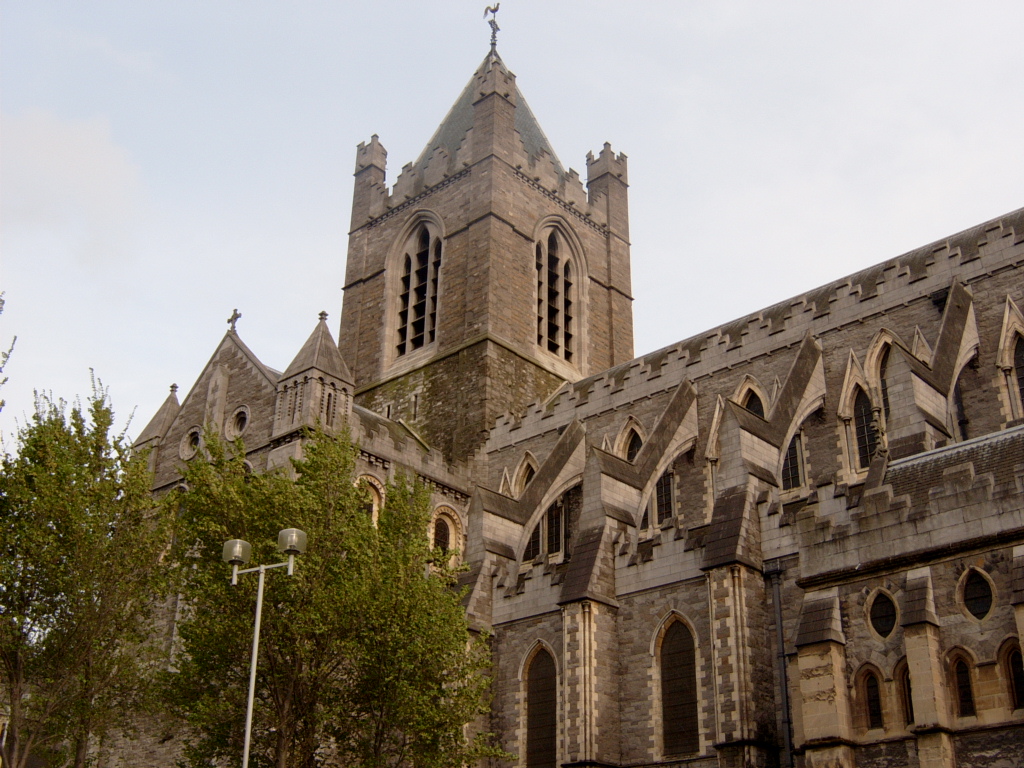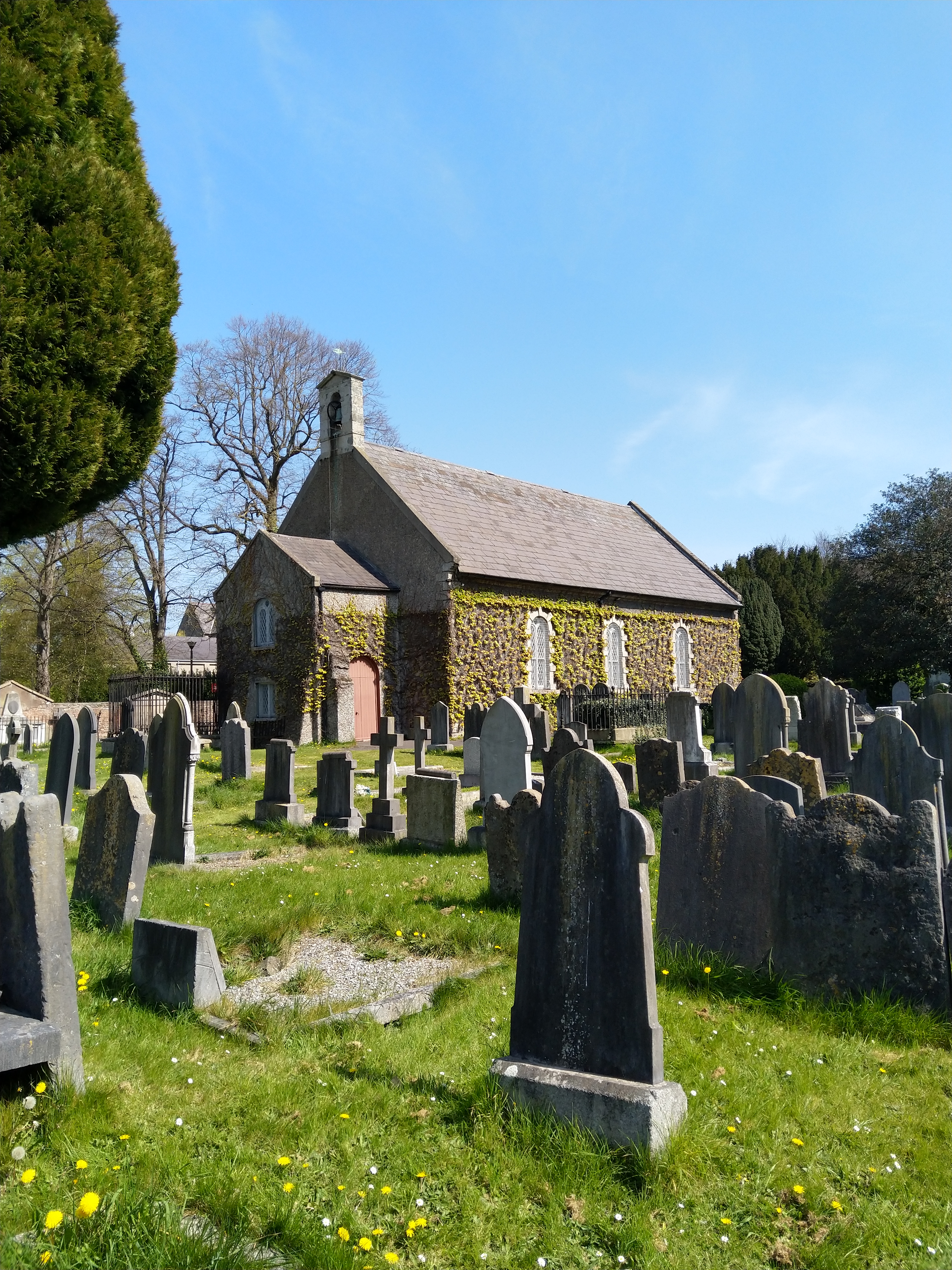|
North Strand Church (Church Of Ireland)
North Strand Church, is a Church of Ireland church on North Strand and Waterloo Avenue, in Dublin. The original church was established in 1786. It is now part of the United Parish of Drumcondra, North Strand, and Saint Barnabas. St. Columba's National School, which was established in 1787, is on the same grounds and affiliated to the church. History Associated Parishes North Strand parish merged with the Parish of Drumcondra in 1896. When St. Barnabas' Church, Dublin on Sherrif Street closed in 1965 it was merged with North Strand. The churches at Drumcondra and North Strand now serve the combined parishes. Since 2017 North Strand and Drumcondra churches also serve the Anglican communities from St. George and St. Thomas parishes. Buildings The original school and chapel were situated on the corner of North Strand and Spring Garden Street. The foundation stone for a new Episcopal Chapel on the current North Strand site was laid on 7 September 1836 by Rev Charles Henry Minchin ... [...More Info...] [...Related Items...] OR: [Wikipedia] [Google] [Baidu] |
North Strand
North Strand (Irish: ''An Trá Thuaidh'' ) is a residential inner city neighbourhood on the Northside of Dublin, Ireland. Location and access The area is physically bounded by the River Tolka to the north and the railway tracks to the east. North Strand is considered to extend to the Five Lamps junction to the south, and to neighbouring Ballybough to the northwest. It lies within two postal districts, Dublin 1 and Dublin 3. The area is bisected from the south-west to northeast by the North Strand Road, which serves as a main arterial route for traffic to and from the city centre and Malahide, Howth and the M50. This road was at one time coastal, before the expansion of Dublin's docklands to the east. The East Wall was constructed to provide access to deeper water for ships, but it also enabled reclamation of the land east of North Strand road and the expansion of Dublin City to the northeast. It is also bisected by the Royal Canal. The Royal Canal and the North Strand Road ... [...More Info...] [...Related Items...] OR: [Wikipedia] [Google] [Baidu] |
Dublin
Dublin (; , or ) is the capital and largest city of Republic of Ireland, Ireland. On a bay at the mouth of the River Liffey, it is in the Provinces of Ireland, province of Leinster, bordered on the south by the Dublin Mountains, a part of the Wicklow Mountains range. At the 2016 census of Ireland, 2016 census it had a population of 1,173,179, while the preliminary results of the 2022 census of Ireland, 2022 census recorded that County Dublin as a whole had a population of 1,450,701, and that the population of the Greater Dublin Area was over 2 million, or roughly 40% of the Republic of Ireland's total population. A settlement was established in the area by the Gaels during or before the 7th century, followed by the Vikings. As the Kings of Dublin, Kingdom of Dublin grew, it became Ireland's principal settlement by the 12th century Anglo-Norman invasion of Ireland. The city expanded rapidly from the 17th century and was briefly the second largest in the British Empire and sixt ... [...More Info...] [...Related Items...] OR: [Wikipedia] [Google] [Baidu] |
Ireland
Ireland ( ; ga, Éire ; Ulster Scots dialect, Ulster-Scots: ) is an island in the Atlantic Ocean, North Atlantic Ocean, in Northwestern Europe, north-western Europe. It is separated from Great Britain to its east by the North Channel (Great Britain and Ireland), North Channel, the Irish Sea, and St George's Channel. Ireland is the List of islands of the British Isles, second-largest island of the British Isles, the List of European islands by area, third-largest in Europe, and the List of islands by area, twentieth-largest on Earth. Geopolitically, Ireland is divided between the Republic of Ireland (officially Names of the Irish state, named Ireland), which covers five-sixths of the island, and Northern Ireland, which is part of the United Kingdom. As of 2022, the Irish population analysis, population of the entire island is just over 7 million, with 5.1 million living in the Republic of Ireland and 1.9 million in Northern Ireland, ranking it the List of European islan ... [...More Info...] [...Related Items...] OR: [Wikipedia] [Google] [Baidu] |
Church Of Ireland
The Church of Ireland ( ga, Eaglais na hÉireann, ; sco, label= Ulster-Scots, Kirk o Airlann, ) is a Christian church in Ireland and an autonomous province of the Anglican Communion. It is organised on an all-Ireland basis and is the second largest Christian church on the island after the Roman Catholic Church. Like other Anglican churches, it has retained elements of pre-Reformation practice, notably its episcopal polity, while rejecting the primacy of the Pope. In theological and liturgical matters, it incorporates many principles of the Reformation, particularly those of the English Reformation, but self-identifies as being both Reformed and Catholic, in that it sees itself as the inheritor of a continuous tradition going back to the founding of Christianity in Ireland. As with other members of the global Anglican communion, individual parishes accommodate different approaches to the level of ritual and formality, variously referred to as High and Low Church. Overvie ... [...More Info...] [...Related Items...] OR: [Wikipedia] [Google] [Baidu] |
Joseph Welland
Joseph Welland (6 May 1798 – 6 March 1860) was born in Middleton, County Cork and became an Irish Architect for the Board of First Fruits and later the Ecclesiastical Commissioners. He was as a student to John Bowden and became his assistant and is noted to have designed many churches and schools around Ireland. While working with John Bowden with the Board of First Fruits, he shared some of Bowden's works. These include St. Philip and St. James Church, Booterstown and St. Stephen's Church, Mount Street (The Pepper Canister), both of which Joseph Welland had to complete himself after Bowden's death in 1821. Joseph Welland died on 6 March 1860 and was buried in St George's churchyard, Dublin. His younger son William Joseph Welland (1832-1895) also designed churches, and worked for the Ecclesiastical Commissioners. Selection of Works *St. Philip and St. James Church, Booterstown (1821) * St. Stephen's Church, Mount Street (The Pepper Canister) (1821) * North Strand Church ... [...More Info...] [...Related Items...] OR: [Wikipedia] [Google] [Baidu] |
Diocese Of Dublin And Glendalough
The United Dioceses of Dublin and Glendalough is a diocese of the Church of Ireland in the east of Ireland. It is headed by the Archbishop of Dublin, who is also styled the Primate of Ireland. The diocesan cathedral is Christ Church Cathedral, Dublin. Overview and history Early Christianity in Ireland The broad Dublin area was Christian long before Dublin had a distinct diocese, with monasteries such as Glendalough as well as at Finglas, Glasnevin, Rathmichael, Swords, Tallaght. Several of these functioned as "head churches" and the most powerful of all was Glendalough. In the early church in Ireland, the church had a monastic basis, with greatest power vested in the Abbots of the major communities. There were bishops but not organised dioceses in the modern sense, and the offices of abbot and bishop were often comprised in one person. Some early "Bishops of Dublin", back to 633, are mentioned in Ware's ''Antiquities of Ireland'' but the Diocese of Dublin is not considered ... [...More Info...] [...Related Items...] OR: [Wikipedia] [Google] [Baidu] |
Province Of Dublin (Church Of Ireland)
The United Provinces of Dublin and Cashel, commonly called the Province of Dublin, and also known as the ''Southern Province'', is one of the two ecclesiastical provinces that together form the Church of Ireland; the other is the Province of Armagh. The province has existed since 1833 when the ancient Province of Dublin was merged with the Province of Cashel. Its metropolitan bishop is the Archbishop of Dublin. The cathedral of the United Provinces of Dublin and Cashel is the Christ Church Cathedral in Dublin. The cathedral is the elder of Dublin's two medieval cathedrals, the other being St. Patrick's Cathedral. The National Synod of the Church of Ireland, published in 1869, includes a statement from representatives of the Provinces of Dublin and Cashel. The statement asserts the independence of the provinces:Whereas, our provinces of Dublin and Cashel, by law and usage, are free from all subjection to the See of Armagh; and we, neither in virtue of our consecration, nor ... [...More Info...] [...Related Items...] OR: [Wikipedia] [Google] [Baidu] |
Drumcondra Church
Drumcondra Church of Ireland is a Church of Ireland church located in Drumcondra, Dublin, previously in the Civil Parish of Clonturk. The church and its churchyard contain memorials to a number of notable historical figures. History In 1743 the dilapidated old church of the parish of Clonturk was rebuilt by a Miss Coghill as a memorial to her brother, who lived in Drumcondra House, Dr. Marmaduke Coghill, who died in 1738. On the northside of the church is the large tomb of Dr. Coghill, born in 1673 in Dublin, who was a judge of the Prerogative Court and Chancellor of the Exchequer, as well as being an MP in the Irish Parliament. On the tomb reclines his effigy in his official robes, with figures of Minerva and Religion below. By about 1721, Marmaduke Coghill was in control of the interments. In 1733 Henry Hamilton was succeeded as incumbent by Edward Hudson, followed by Robert Johnson in 1740, in 1748 James Edkins, 1781 Charles O'Neill, 1789 Jacob Cramer, 1816 William Barlow, ... [...More Info...] [...Related Items...] OR: [Wikipedia] [Google] [Baidu] |
Éamon De Valera
Éamon de Valera (, ; first registered as George de Valero; changed some time before 1901 to Edward de Valera; 14 October 1882 – 29 August 1975) was a prominent Irish statesman and political leader. He served several terms as head of government and head of state and had a leading role in introducing the 1937 Constitution of Ireland. Prior to de Valera's political career, he was a commandant of Irish Volunteers at Boland's Mill during the Easter Rising, 1916 Easter Rising. He was arrested and sentenced to death but released for a variety of reasons, including the public response to the British execution of Rising leaders. He returned to Ireland after being jailed in England and became one of the leading political figures of the Irish War of Independence, War of Independence. After the signing of the Anglo-Irish Treaty, de Valera served as the political leader of Anti-Treaty Sinn Féin until 1926, when he, along with many supporters, left the party to set up Fianna Fáil, a new ... [...More Info...] [...Related Items...] OR: [Wikipedia] [Google] [Baidu] |
Joseph Singer (bishop)
Joseph Henderson Singer (1786–1866) was an Irish Anglican bishop in the Church of Ireland in the 19th century. He was the son of James Singer the Deputy Commissary-General of the Forces in Ireland and Elizabeth Henderson. He became a Fellow of Trinity College Dublin in 1810 and was subsequently its Regius Professor of Divinity and Erasmus Smith's Professor of Modern History. He became Bishop of Meath in 1852 and died in post on 16 July 1866. Dr. Singer was a member of and served as secretary to the Royal Irish Academy. He was a leading member of the Evangelical body of the Irish Church and a strong opponent to the National Board of Education. Rev. Singer served as Chaplain to the Magdalen Asylum on Leeson Street. He served on committees and was a trustee a number of Church of Ireland and benevolent societies, such as the Protestant Orphan Society, as secretary of the Hibernian Bible Society, a trustee of North Strand Episcopal Chapel and Schools. He was a committee member ... [...More Info...] [...Related Items...] OR: [Wikipedia] [Google] [Baidu] |
William Henry Krause
William Henry Krause, (1796-1852) was a Church of Ireland priest and noted preacher. Krause was born on the island of Saint Croix in the West Indies in 1796.''Evangelical Protestantism in Ulster Society 1740-1890'' By David Hampton, Myrtle Hull. Brought up in England, he was educated at Fulham and Richmond. He joined the army at 18, and fought in France, and at the Battle of Waterloo in 1815, with the 51st, Second West York, King's Own Light Infantry. After leaving the army, due to illness, he returned to his father in St. Croix. In 1822 he visited Ireland for the wedding of a friend, where he met Angelina Ridgeway and married her, she was instrumental in his conversion to evangelical Protestantism. Angelina Ridgeway Krause died shortly after giving birth to their only child Eliza Angelina Krause.''W.H.K. Pollock: A Chess Biography with 523 Games'' By Olimpiu G. Urcan, John S. Hilbert After seeking ordination unsuccessfully in England, Krause moved to Cavan where he worked for the ... [...More Info...] [...Related Items...] OR: [Wikipedia] [Google] [Baidu] |
Arthur Guinness, 1st Baron Ardilaun
Arthur Edward Guinness, 1st Baron Ardilaun, 2nd Baronet (1 November 1840 – 20 January 1915), known as Sir Arthur Guinness, Bt, between 1868 and 1880, was an Irish businessman, politician, and philanthropist, best known for giving St Stephen's Green to the Dublin Corporation for public use. Background and education Guinness was born at St Anne's, Raheny, near Dublin, the eldest son of Sir Benjamin Guinness, 1st Baronet, and elder brother of Edward Guinness, 1st Earl of Iveagh. He was the great-grandson of Arthur Guinness. He was educated at Eton and Trinity College Dublin, and in 1868 succeeded his father as second Baronet. Political life In 1868 Guinness was elected Conservative Member of Parliament for the City of Dublin, a seat he held for only a year. His election was voided because of his election agent's unlawful efforts, which the court found were unknown to him. He was re-elected at the next election in 1874. A supporter of Disraeli's "one nation" conservatism, his ... [...More Info...] [...Related Items...] OR: [Wikipedia] [Google] [Baidu] |







.jpg)
.jpg)